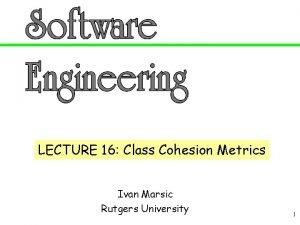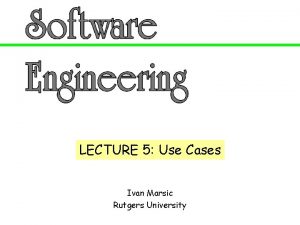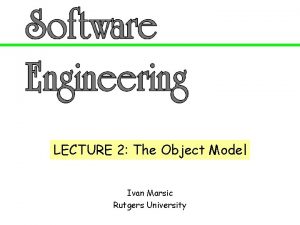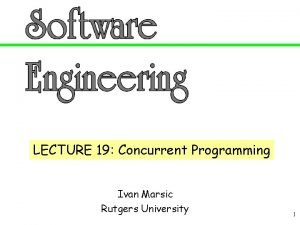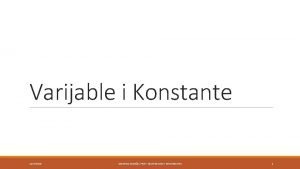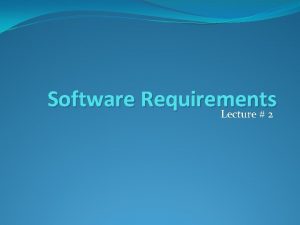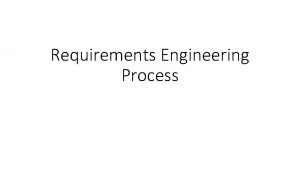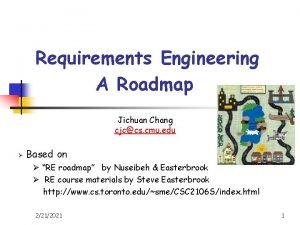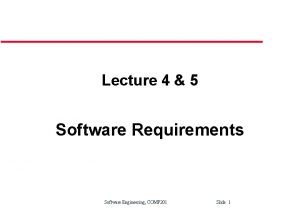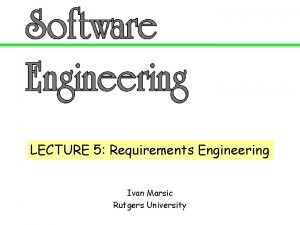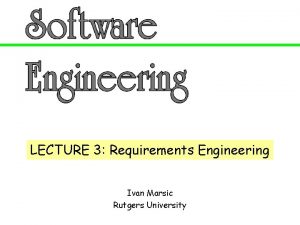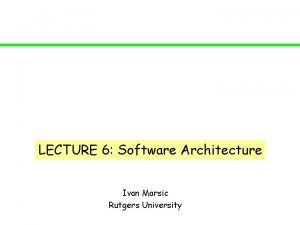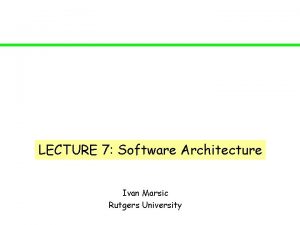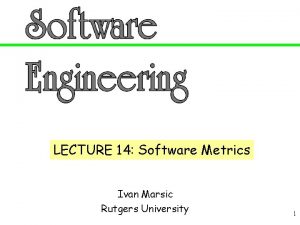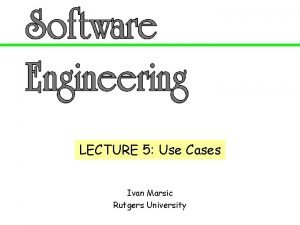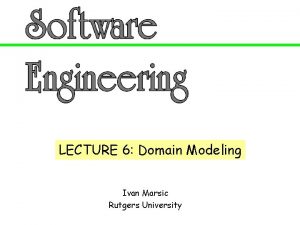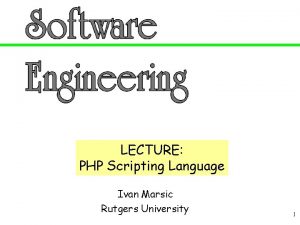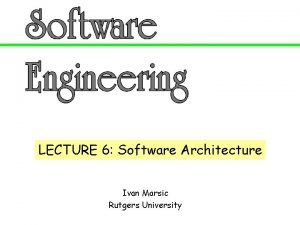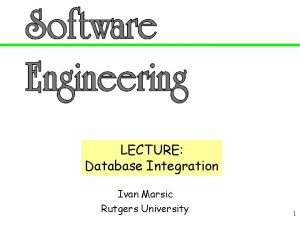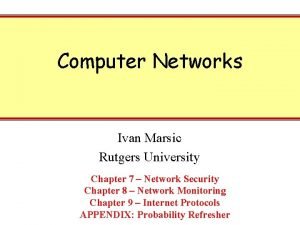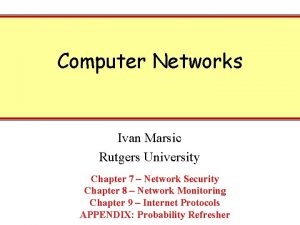LECTURE 3 Requirements Engineering Ivan Marsic Rutgers University




















- Slides: 20

LECTURE 3: Requirements Engineering Ivan Marsic Rutgers University

Topics • • • Requirements Engineering Components Requirements and User Stories Types of Requirements Effort Estimation (Agile Methods) 2

“The hardest single part of building a software system is deciding what to build. No part of the work so cripples the resulting system if done wrong. No other part is more difficult to rectify later. ”—Fred Brooks “You start coding. I’ll go find out what they want. ” —Computer analyst to programmer 3

Requirements Engineering • Requirements engineering helps software engineers understand the problem they are to solve. It involves activities that lead to understanding the business context, what the customer wants, how end-users will interact with the software, and what the business impact will be. • The key task of requirements engineering is formulating a welldefined problem to solve. A well defined problem includes – A set of criteria (“requirements”) according to which proposed solutions either definitely solve the problem or fail to solve it – The description of the resources and components at disposal to solve the problem. • A stakeholder is an individual, team, or organization with interests in, or concerns related to, the system-to-be. 4

Requirements Process Aspect-Oriented Requirements Object-Oriented Analysis & Design Requirements gathering Requirements analysis Requirements specification Structured Analysis & Design Agile Development User Stories 5

Requirements Engineering Components • Requirements gathering – (a. k. a. “requirements elicitation”) helps the customer to define what is required: what is to be accomplished, how the system will fit into the needs of the business, and how the system will be used on a day-to-day basis • Requirements analysis – involves refining of and reasoning about the requirements received from the customer during requirements gathering. • Requirements specification – documenting the system requirements in a semiformal or formal manner to ensure clarity, consistency, and completeness • Prototype, formal model, and UML 6

Writing Sys: Reqs: • Software system requirements are usually written in the form of statements “The system shall …” or “The system should …” The “shall” form is used for features that must be implemented and the “should” form for desirable but not mandatory features. 7

Example System Requirements Identifier Priority REQ 1 5 REQ 2 2 5 REQ 3 Requirement The system shall keep the door locked at all times, unless commanded otherwise by authorized user. When the lock is disarmed, a countdown shall be initiated at the end of which the lock shall be automatically armed (if still disarmed). The system shall lock the door when commanded by pressing a dedicated button. The system shall, given a valid key code, unlock the door and activate other devices. The system should allow mistakes while entering the key code. However, to resist “dictionary attacks, ” the number of allowed failed attempts shall be small, say three, after which the system will block and the alarm bell shall be sounded. REQ 4 4 REQ 5 REQ 6 2 2 REQ 7 2 The system shall allow configuring the preferences for device activation when the user provides a valid key code, as well as when a burglary attempt is detected. REQ 8 1 The system should allow searching the history log by specifying one or more of these parameters: the time frame, the actor role, the door location, or the event type (unlock, power failure, etc. ). This function shall be available over the Web by pointing a browser to a specified URL. REQ 9 1 The system should allow filing inquiries about “suspicious” accesses. This function shall be available over the Web. The system shall maintain a history log of all attempted accesses for later review. The system should allow adding new authorized persons at runtime or removing existing ones. 8

User Stories As a tenant, I can unlock the doors to enter my apartment. user-role (benefactor) capability business-value • Similar to system requirements, but focus on the user benefits, instead on system features. • Preferred tool in agile methods. 9

Example User Stories Identifier User Story Size ST-1 As an authorized person (tenant or landlord), I can keep the doors locked at all times. 4 points ST-2 As an authorized person (tenant or landlord), I can lock the doors on demand. 3 pts ST-3 The lock should be automatically locked after a defined period of time. 6 pts ST-4 As an authorized person (tenant or landlord), I can unlock the doors. (Test: Allow a small number of mistakes, say three. ) ST-5 As a landlord, I can at runtime manage authorized persons. 10 pts ST-6 As an authorized person (tenant or landlord), I can view past accesses. 6 pts ST-7 As a tenant, I can configure the preferences for activation of various devices. 6 pts ST-8 As a tenant, I can file complaint about “suspicious” accesses. 6 pts 9 points 10

Types of Requirements • Functional Requirements: determine the system’s expected behavior and the effects it should produce in the problem domain. These requirements generally represent the main product features. • Non-functional requirements – FURPS+ – Functionality (security), Usability, Reliability, Performance , Supportability 11

FURPS • • The term FURPS+ refers to the non-functional system properties: Functionality lists additional functional requirements that might be considered, such as security, which refers to ensuring data integrity and authorized access to information • Usability refers to the ease of use, esthetics, consistency, and documentation—a system that is difficult and confusing to use will likely fail to accomplish its intended purpose • Reliability specifies the expected frequency of system failure under certain operating conditions, as well as recoverability, predictability, accuracy, and mean time to failure • Performance details the computing speed, efficiency, resource consumption, throughput, and response time • Supportability characterizes testability, adaptability, maintainability, compatibility, configurability, installability, scalability, and localizability 12

Requirements prioritization • In most cases, not all requirements can be realized because of budgetary or time constraints. Therefore, it is necessary to prioritize the requirements. 1. Essential: have to be realized to make the system acceptable to the customer. 2. Desirable: highly desirable, but not mandatory requirements 3. Optional: might be realized if time and resources permit 4. Future: will not be realized in the current version of the system-to-be, but should be recorded for consideration in future versions • The priority of requirements determines the order in 13 which they will be implemented.

Tools for Requirements Eng. • Tools, such as user stories and use cases, used for – Determining what exactly the user needs (“requirements analysis”) – Writing a description of what system will do (“requirements specification”) • Difficult to use the same tool for different tasks 14

Project Estimation using User Story Points • Similar to “hedge pruning points” in the first lecture • Points assigned to individual user stories • Total work size estimate: points-for-story – Total size = i (i = 1. . N) • Velocity (= productivity) estimated from experience • Estimate the work duration Project duration = Path size Travel velocity 15

Example User Stories Identifier User Story Size ST-1 As an authorized person (tenant or landlord), I can keep the doors locked at all times. 4 points ST-2 As an authorized person (tenant or landlord), I can lock the doors on demand. 3 pts ST-3 The lock should be automatically locked after a defined period of time. 6 pts ST-4 As an authorized person (tenant or landlord), I can unlock the doors. (Test: Allow a small number of mistakes, say three. ) ST-5 As a landlord, I can at runtime manage authorized persons. 10 pts ST-6 As an authorized person (tenant or landlord), I can view past accesses. 6 pts ST-7 As a tenant, I can configure the preferences for activation of various devices. 6 pts ST-8 As a tenant, I can file complaint about “suspicious” accesses. 6 pts 9 points 16

Agile Project Effort Estimation 17

How To Combine the Part Sizes? Costs are not always additive But, solution (c) is not necessarily “cheaper” than (b) … 18

Additional Costs Highway traffic-circle interchange Traffic signs 19

Agile Estimation of Project Effort Work backlog 1) ST-4: Unlock 2) ST-2: Lock 1) Prune Section 6 1 day (2 pts) 2) Prune Section 5 2 days (4 pts) 3) Prune Section 7 2 days (4 pts) 4) Prune Section 4 1. 5 days (3 p) 5) Prune Section 8 3. 5 days (7 p) Estimated work duration 15 days (9 pts) 5 days (3 pts) Items pulled by the team into an iteration 3) ST-5: Manage Users 16 days (10 pts) 4) ST-7: Preferences 10 days (6 pts) 5) ST-6: View History 10 days (6 pts) 6) ST-… Work items 21 days 1 st iteration 2 nd iteration n-th iteration 5 days List prioritized by the customer Estimated completion date Time 2 points per day 1 = 4 pts (2 days) 2 = 7 pts (3. 5 days) 3 = 10 pts (5 days) 4 = 3 pts (1. 5 days) 5 = 4 pts (2 days) 6 = 2 pts (1 day) 7 = 4 pts (2 days) 8 = 7 pts (3. 5 days)
 Lcom tcc
Lcom tcc Ivan marsic
Ivan marsic Deus ex machina ivan milat
Deus ex machina ivan milat Ivan marsic
Ivan marsic Martina maršić
Martina maršić 01:640:244 lecture notes - lecture 15: plat, idah, farad
01:640:244 lecture notes - lecture 15: plat, idah, farad Money-time relationship and equivalence
Money-time relationship and equivalence Requirement analysis in software engineering notes
Requirement analysis in software engineering notes Foundation engineering lecture notes
Foundation engineering lecture notes Engineering ethics lecture notes
Engineering ethics lecture notes Engineering requirements document
Engineering requirements document Domain requirements
Domain requirements Inverse requirements
Inverse requirements High level requirements
High level requirements Requirements discovery techniques in software engineering
Requirements discovery techniques in software engineering Requirements engineering process
Requirements engineering process Requirements writing for system engineering
Requirements writing for system engineering Domain requirements
Domain requirements Requirements engineering process
Requirements engineering process Requirements engineering a roadmap
Requirements engineering a roadmap Domain requirements
Domain requirements
